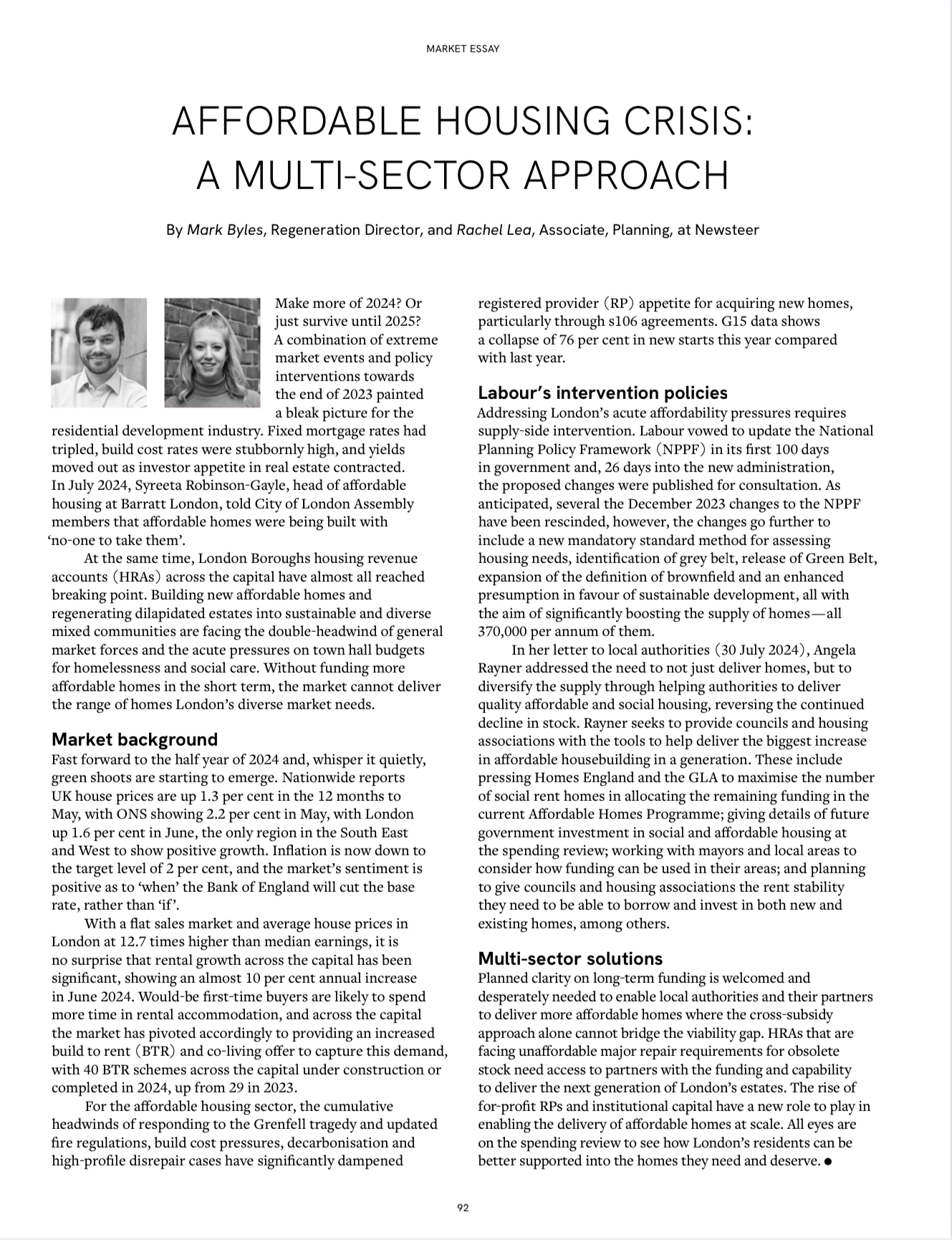This article, written by Mark Byles and Rachel Lea, was first published in NLQ Autumn 2024.
Make more of 2024? Or just survive until 2025? A combination of extreme market events and policy interventions towards the end of 2023 painted a bleak picture for the residential development industry. Fixed mortgage rates had tripled, build cost rates were stubbornly high, and yields moved out as investor appetite in real estate contracted.
In July 2024, Syreeta Robinson-Gayle, head of affordable housing at Barratt London, told City of London Assembly members that affordable homes were being built with ‘no-one to take them’.At the same time, London Boroughs housing revenue accounts (HRAs) across the capital have almost all reached breaking point. Building new affordable homes and regenerating dilapidated estates into sustainable and diverse mixed communities are facing the double-headwind of general market forces and the acute pressures on town hall budgets for homelessness and social care. Without funding more affordable homes in the short term, the market cannot deliver the range of homes London’s diverse market needs.
Market background
Fast forward to the half year of 2024 and, whisper it quietly, green shoots are starting to emerge. Nationwide reports UK house prices are up 1.3 per cent in the 12 months to May, with ONS showing 2.2 per cent in May, with London up 1.6 per cent in June, the only region in the South East and West to show positive growth. Inflation is now down to the target level of 2 per cent, and the market’s sentiment is positive as to ‘when’ the Bank of England will cut the base rate, rather than ‘if’.
With a flat sales market and average house prices in London at 12.7 times higher than median earnings, it is no surprise that rental growth across the capital has been significant, showing an almost 10 per cent annual increase in June 2024. Would-be first-time buyers are likely to spend more time in rental accommodation, and across the capital the market has pivoted accordingly to providing an increased build to rent (BTR) and co-living offer to capture this demand, with 40 BTR schemes across the capital under construction or completed in 2024, up from 29 in 2023.
For the affordable housing sector, the cumulative headwinds of responding to the Grenfell tragedy and updated fire regulations, build cost pressures, decarbonisation and high-profile disrepair cases have significantly dampened registered provider (RP) appetite for acquiring new homes, particularly through s106 agreements. G15 data shows a collapse of 76 per cent in new starts this year compared with last year.
Labour’s intervention policies
Addressing London’s acute affordability pressures requires supply-side intervention. Labour vowed to update the National Planning Policy Framework (NPPF) in its first 100 days in government and, 26 days into the new administration, the proposed changes were published for consultation. As anticipated, several the December 2023 changes to the NPPF have been rescinded, however, the changes go further to include a new mandatory standard method for assessing housing needs, identification of grey belt, release of Green Belt, expansion of the definition of brownfield and an enhanced presumption in favour of sustainable development, all with the aim of significantly boosting the supply of homes —all 370,000 per annum of them.
In her letter to local authorities (30 July 2024), Angela Rayner addressed the need to not just deliver homes, but to diversify the supply through helping authorities to deliver quality affordable and social housing, reversing the continued decline in stock. Rayner seeks to provide councils and housing associations with the tools to help deliver the biggest increase in affordable housebuilding in a generation. These include pressing Homes England and the GLA to maximise the number of social rent homes in allocating the remaining funding in the current Affordable Homes Programme; giving details of future government investment in social and affordable housing at the spending review; working with mayors and local areas to consider how funding can be used in their areas; and planning to give councils and housing associations the rent stability they need to be able to borrow and invest in both new and existing homes, among others.
Multi-sector solutions
Planned clarity on long-term funding is welcomed and desperately needed to enable local authorities and their partners to deliver more affordable homes where the cross-subsidy approach alone cannot bridge the viability gap. HRAs that are facing unaffordable major repair requirements for obsolete stock need access to partners with the funding and capability to deliver the next generation of London’s estates. The rise of for-profit RPs and institutional capital have a new role to play in enabling the delivery of affordable homes at scale. All eyes are on the spending review to see how London’s residents can be better supported into the homes they need and deserve.

